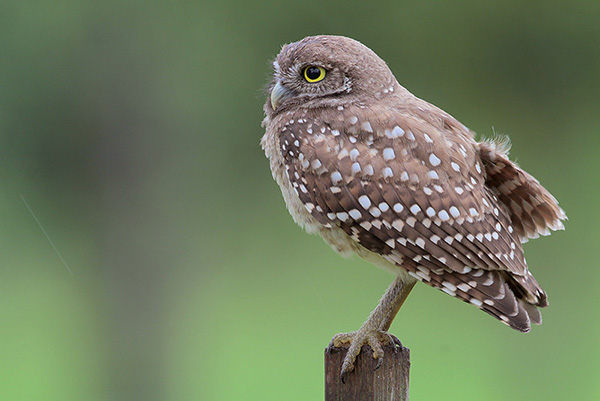Meet the Burrowing Owl (Athene cunicularia) – a small long-legged and round-headed bird of prey that can be seen comically running around an open field, hunting for food.
They are known for their distinctive behaviors, including their ability to live in underground burrows. As they are also active during the day, it’s quite easy to see one if you know where to look.
On this page
Breeding Male
Male Burrowing Owls are brown with white mottling, yellow eyes, white eyebrows, and a dirty yellow bill. Their underside is a bit lighter than their upper side. Males can appear lighter in color and have longer wings and tails.
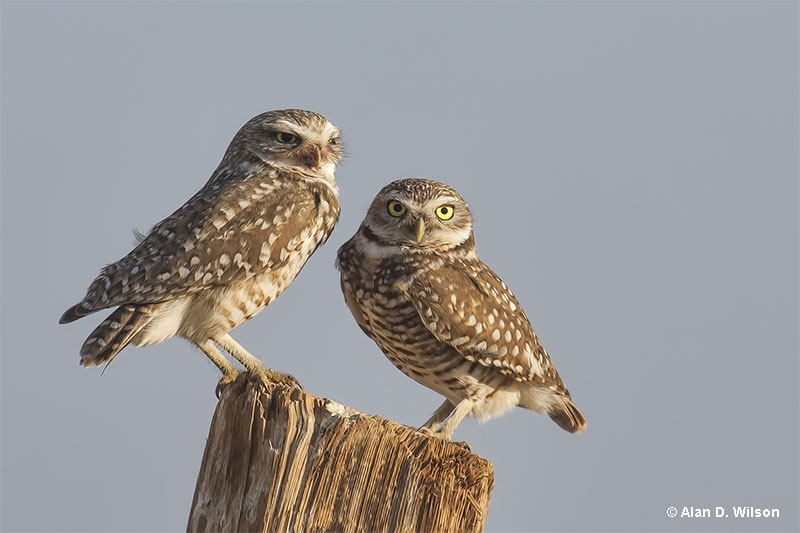
© Alan D. Wilson
Female
Female Burrowing Owls look very similar to males. The only difference is that they appear darker in color because they spend more time in the burrows. They are usually heavier than males.
Related: Owl identification
Juvenile
Females lay 2-12 smooth white eggs in a clutch and incubate them for 28-30 days while the males provide food. For the first two weeks, the female remains with the hatchlings and the male brings food. After about 6 weeks, the offspring leave the nest and become fully independent soon after that.
Juvenile Burrowing Owls are more uniformly colored than adults. Their throats are white, their underside buffy, and they also have a buff-colored patch on their wings.
Burrowing Owls are on the smaller side and grow to be 7.5-9.8 inches long and weigh around 5 ounces.
Habitat
Burrowing Owl habitats are flat open areas with very short vegetation and a few trees. These include open grasslands, farmland, prairies, deserts, plains, and also urban areas such as airfields and golf courses.
As the name suggests, Burrowing Owls nest in burrows, which are ideally surrounded by short grass.
Some birds dig their own burrows, but most use burrows dug by other animals, such as prairie dogs, armadillos, etc. They often line the entrance with manure, sometimes with grass, feathers, and other matter.
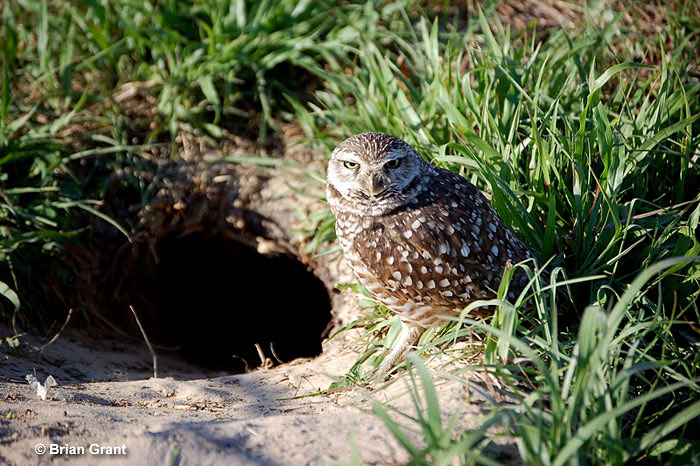
Diet
Burrowing Owl’s diet includes a variety of arthropods, small mammals and birds, reptiles, worms, and other animal matter. Their diet varies depending on the season and location.
During the summer, they mostly eat insects, such as beetles, grasshoppers, crickets, moths, caterpillars, centipedes, scorpions, etc. During other times of the year, they mostly feed on small mammals, such as mice and ground squirrels, some small birds, frogs, lizards, small snakes, lizards, bats, and even other young Burrowing Owls.
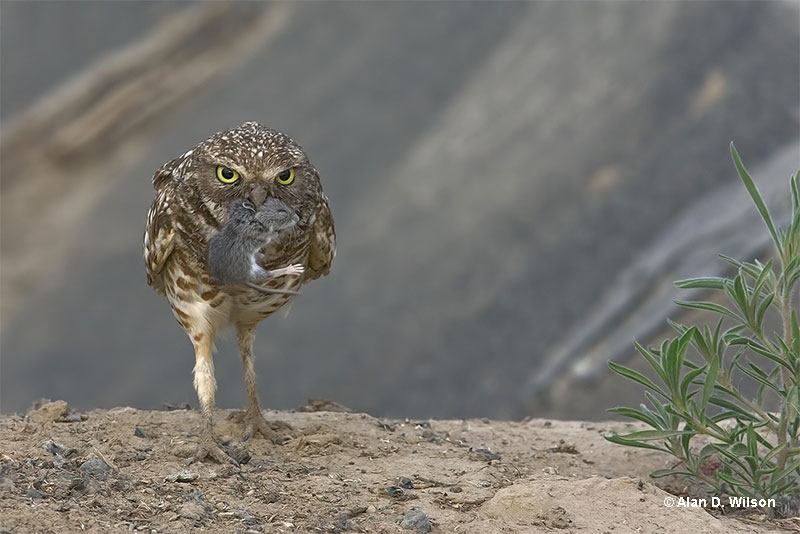
© Alan D. Wilson
They mostly hunt at dusk or at night, but during the breeding season, they also hunt during the day. These owls make use of different hunting techniques depending on what kind of prey they’re trying to catch.
Keep reading: What do owls eat?
Methods include perch-hunting, hovering, or even running along the ground or catching insects mid-air.
Behavior
You can see Burrowing Owls both during the day and at night. They either hunt or sleep at their burrow entrance or somewhere on the ground. If the birds are disturbed or hunting, they bob their heads up and down.
When threatened, Burrowing Owls try to scare the attacker away by screaming, chattering, or clucking, and by flapping wings and snapping bills.
Overall, Burrowing Owls are monogamous and breed in loose colonies. You can see the younglings practice their hunting skills by jumping on each other or on prey brought by their parents.
Range (and seasonal changes)
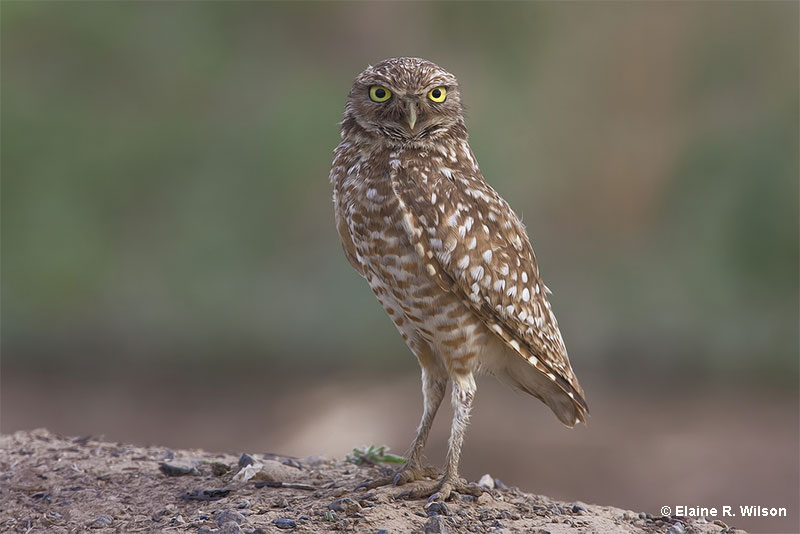
© Elaine R. Wilson
Burrowing Owls range throughout most of western North America, Central America, and a large part of South America. Their breeding range extends from the western part of the United States to the southern parts of Saskatchewan and Manitoba in Canada.
The populations in South America, the western part of the southern U.S., Florida, the Caribbean Islands, and northern Central America are year-round residents. The birds from the northern areas migrate to Central America for the winter.
Currently, Burrowing Owls are listed as of least concern on the IUCN Red List. However, their population is in a decline due to habitat loss.
Wing shape
Burrowing Owls have a wingspan of 20-24 inches, twice as long as the length of their bodies. Their rounded wings have a large surface area, which lets them fly and glide for long periods of time.
Their velvety feathers allow them to stay silent while flying and remain undetected by prey.
Fun Facts
- Burrowing Owls have 18 recognized subspecies, of which two are unfortunately extinct. They are differentiated by their range and appearance, with the most notable differences residing in the color of the beak, the specific shade of the plumage, and the degree of mottling.
- Burrowing Owls are avid hunters who think ahead. They store extra kills in their burrows so that they would have enough food during the breeding season. The birds also drag animal dung in front of the entrance of the burrow for an easy supply of insects.
- Burrowing Owls are accepting of unconventional nesting spaces. This makes the conservationists’ job slightly easier, as the birds accept buckets, pipes, and other similar artificial sites as their nesting place.
- When threatened or disturbed, Burrowing Owls try to avoid being detected by laying flat on the ground. However, their owlets mimic the sound of a rattlesnake to scare away potential predators.
- Burrowing Owls can rotate their heads 270 degrees.
Call
Burrowing Owls have many different sounds for different purposes. Although they’re not very vocal, they can coo, cluck, scream, and produce warbling and rattling sounds.
Burrowing Owls commonly call with a quick and high-pitched coo-cooo or co-hoo. Owlets whine for food, hiss in defense, and produce a scratching eep sound when raising alarm.
Similar Species
Although Burrowing Owls are easy to recognize, they can still be confused with some other species.
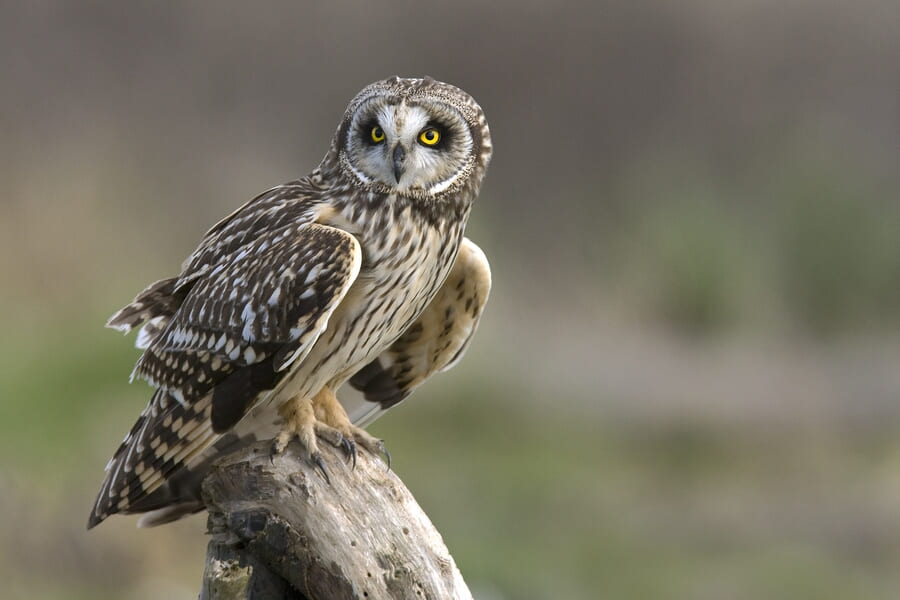
Short-eared Owl
Compared to Burrowing Owls, Short-eared Owls have a stockier build. Since Burrowing Owls primarily live on the ground, they have long, prominent legs.
Short-eared Owls nest on the ground, but they can be seen in the air much more than Burrowing Owls. Burrowing Owls, on the other hand, nest in burrows and forage on the ground.
The two share some overlapping in their respective ranges.
Frequently Asked Questions
Why are Burrowing Owls important?
Burrowing Owls are an important part of the ecosystem and are also valuable to humans. They hunt rodents, insects, and agricultural pests, helping to prevent the spread of diseases.
Can a Burrowing Owl fly?
Burrowing Owls can fly, although they’re less likely to do so as they spend most of their time underground in their burrows.
Where do most Burrowing Owls live?
Most Burrowing Owls can be found throughout open areas of western North America and Central and South America. They live in burrows, preferring burrows dug by other animals, such as prairie dogs.
Where is the best place to see Burrowing Owls?
The best place to see Burrowing Owls is around open fields with short or no vegetation. They especially prefer to live in prairie dog and ground squirrel tunnels.

